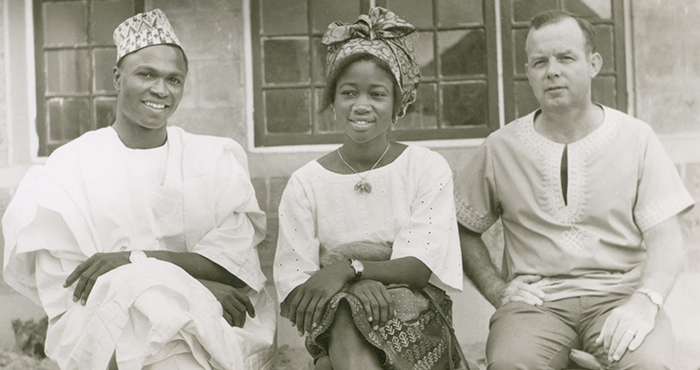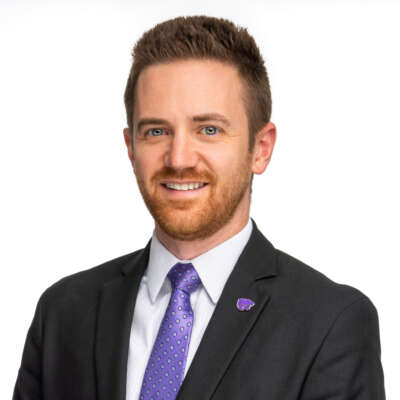In the last issue of Good for K-State, we introduced you to K-State students and faculty who are changing the world in large and small ways. We invited you to share your K-State stories and how you are changing the world. Dozens of Wildcats responded and sent many inspiring and interesting stories. Here are a few.
Warren Prawl, 1954
“My lifetime of adventure focused on agricultural development around the world. Like many K-State graduates, I came from a very rural Kansas county with little idea of what the world had to offer. After learning about the 4-H International Farm Youth Exchange, I applied, was accepted and spent six months living and working with farm families in Switzerland. Those months abroad changed the way I looked at life and influenced the many decisions I made after graduating in 1954. After the Army and graduate school, I accepted a position with the American Friends Service Committee as an extension worker in an agricultural development project in rural India. After I earned a doctorate in education at Cornell University, K-State took me on as an extension specialist with its agricultural development program in Hyderabad, India. I spent four years in India, four years in Nigeria, four years in Tunisia and two in Cameroon, all with KSU-related programs.” After retirement in 1988, Warren continued as an agricultural development consultant for another 15 years, including several assignments with the Food and Agricultural Organization of the United Nations in several African and southeastern Asia countries.
Annie Gough, 1997
“In 1993, the head of the art department, Diane Dollar, allowed me to take art classes even though I was a pre-med student. Her flexibility paved my career path. Biology professors Jerry Weis and Larry Williams were also the most encouraging! I went on to graduate with a Masters of Science in medical illustration from the Medical College of Georgia. Today I am the author of Injury Illustrated: How Medical Images Win Legal Cases. I have spent 20 years specializing in attorney and jury education, creating anatomical and surgical drawings for traumatic injury and medical malpractice cases.”
Karen Nickel-Creusere, 1966
“I have retired after 33 years in the San Francisco Bay area as a Ph.D. clinical chemist. The last 22 years, I worked for the California Department of Public Health. I never could have done this without my start at K-State.” During her career, Karen was nationally recognized in the fields of clinical chemistry and endocrinology, holding leadership positions in several national organizations. In 1993, when she accepted the Chief of Laboratory Field Services for the California Department of Health Services role, she was the first “outsider” and woman to fill this position.
DeAnne Witherspoon, 1978
“There was an optics class that I wanted to take that was only offered once every four semesters. I signed up for the class my senior year, only to be told by the head of the physics department that the class didn’t make enrollment. I explained that I had waited two years to take this class because I was applying to optometry school. The head of the physics department decided to teach me optics one-on-one, two days a week in his office. I served my state as the first female president of our optometry association, held regional board leadership positions and successfully retired after 40 years. I look back on my years at KSU as some of the best. And I really appreciate that head of the physics department in 1978. I hope I have given back as much as he did.”
Mary Margaret Arnold Erlanger, 1943
“I grew up in Manhattan and loved Kansas State. I was the editor of the Collegian and Royal Purple, and I worked at the Manhattan Mercury Chronicle. I graduated in 1943 and took a job as a reporter at the Topeka State Journal. It was the height of World War II and on my beat was a Navy recruiting office, and they persuaded me to apply for officer training at Smith College. I became a communications officer in 1944 and was stationed in Washington D.C. to code and decode messages to and from ships at sea. After the war, I went to New York City where I wound up at CBS, married a New Yorker, Michael Erlanger, and ultimately moved to Connecticut. I became president of the state League of Women Voters and got involved in politics. In 1980, I decided to go back to school and got a doctorate in counseling psychology and went into practice in Athens, Georgia. I retired at the age of 86 (Michael had died in 2002) and I moved back to Connecticut to a multi-level retirement community. I’m in pretty good shape for the age of 98! I spend much of my time embracing my memories, many of which are of my years at K-State.”
Keith Hooper, 1966 & 1970
“I received a B.A. and an M.S. from K-State. I have always been a Wildcat fan and credit the KSU department of foods and nutrition and US Army for laying the groundwork for my ‘boots on the ground’ approach to helping the less fortunate. While most people our ages (82 and 77) are retired, my wife and I are still in the fast lane!” Keith was a Peace Corps volunteer in the Philippines teaching and doing community development work. He and his wife, Paterna, have worked with lepers, organized Special Olympics in Germany, oversaw feeding refugees in Iraq and provided funding for the education of the less fortunate in the Philippines. They formalized their charitable work in 2004 by forming The HELP Foundation.
Stan Husted, 1967 & 1969
“In 1997, I began volunteering at a nursing home in Palm Desert, California. Later that year, Jill (KSU ’71) and I moved to Danville, CA, where I began visiting the homebound and people in assisted living facilities. Making a difference was due in large part to a visit to Manhattan, when I was there to award the fifth annual scholarship to a Manhattan High School senior in memory of Jill who died in 2003. Before going to MHS, I visited my retired KSU major professor, Dr. Robert B. Mills, a resident of Meadowlark Hills Retirement Community. He told me to talk to Steve Shields, who gave me his book, In Pursuit of the Sunbeam, a guide to transform nursing homes into facilities devoted to person-centered care. When I retired, I volunteered with the California Culture Change Coalition, a nonprofit organization devoted to changing nursing homes from task-oriented care to person-centered care. Like my 40-year career as an entomologist, K-State and Manhattan were at the center of my 22 years bringing friendship and joy to the elderly.”
Alejandra Juarez, 2007
“Like many K-Staters, I feel that my time in Manhattan instilled in me a sense of service and a calling to work toward a cause. As part of the BESITOS scholarship program and BESO student organization, I volunteered in my community, worked with my peers to advance education for English language learners, and supported the mission of the College of Education. Now, I serve as a behavioral health advocate, striving to educate organizations and communities on placing a greater focus on mental health and opening up access to care and resources.”






